Unsure about your French table manners? Click Here to download > > How to avoid these 10 food etiquette mistakes !
- Home ›
- Plan Your France Trip ›
- France in Winter
9 Destinations That Make Winter in France a Great Time to Visit
Published 17 November 2025 by Leyla Alyanak — Parisian by birth, Lyonnaise by adoption, historian by passion
Winter in France comes in many forms — snow in the Alps, sun in Provence, mist in the Dordogne, festivals in Alsace. This guide shows you where to find the kind of winter you want, with nine regions that shine between December and March.
France in winter is a country of contrasts.
The pace shifts as the winter season sets in: mountain resorts move into high gear, Christmas regions stay lively into early January, big cities carry on as usual, and smaller towns quietly slow down for their annual break.
It’s a mix of bright festivals and pockets of real winter calm, and the two may be just a short train ride apart.
This diversity makes France in winter a great time to visit, whatever your feelings about winter.
If you're planning a winter trip, compare winter hotel options across France before you go.
NOTE: Pages on this site may contain affiliate links, which support this site. See full Privacy Policy here.
What to expect in France in winter
WINTER IN FRANCE: PROS AND CONS AT A GLANCE
✅ Pros
- Fewer crowds at major sites
- Lower hotel prices (outside ski resorts)
- Christmas markets and winter festivals
- Clear, bright weather in the south
- Superb skiing conditions in the mountains
❌ Cons
- Shorter daylight hours
- Reduced transport in rural areas
- Some restaurants/hotels closed in small towns
- Occasional strikes (especially in January)
- Cold interiors in older buildings
France stretches across several climate zones, so winter looks different depending on where you stand. You might find snow in the mountains, rain on the Atlantic coast, fog in the valleys, and sunshine along the Mediterranean. Here’s the broad picture at a glance.
If you want to choose your kind of French winter
Prefer snow? Head for the Alps, Jura, or Pyrenees.
For sunshine, on the other hand, try Provence, the French Riviera, Corsica, or Guadeloupe.
If you're looking for festivals, go for Strasbourg’s Christmas markets, Lyon’s light festival, or the Nice and Menton carnivals.
And if you're craving quiet museums and fewer crowds, then Paris, the Loire Valley and Normandy are ideal in January.

FRANCE WINTER AT A GLANCE
From snow to sunshine, winter in France weather changes personality every few hundred kilometres.
- In the mountains (Alps, Jura, Pyrenees), you’ll find deep snow, ski slopes, and thermal spas, though it's milder in the foothills.
- In Alsace, expect cold days, fairy-lit towns, and Christmas markets that taper off after New Year. In the northern areas of Alsace and Lorraine, along with the windswept plateaus of the Haute-Marne, expect more snow as you get closer to Germany.
- Paris and the north stay mild and gray – ideal for museums, cafés, and the January sales.
- Normandy and Brittany are windy and dramatic, best for coastal walks and seafood, but not sunbathing.
- The Loire Valley glows under winter light, but bring layers: châteaux can be colder inside than out.
- Provence and the Riviera trade lavender for mimosa and clear skies; smaller villages nearly close down till spring, but you'll love the sunshine.
- The southwest (Dordogne, Bordeaux, Basque Country) keeps its markets and wine routes open, though mist and fog roll through the valleys.
- Corsica offers empty beaches and snow in its interior on the same day.
- And if you crave real warmth, Overseas France – from Guadeloupe to Réunion – enjoys tropical summer while mainland France huddles by the fire.
Not only does weather vary hugely among regions, it can also vary within a single region, depending on the year.
For example, where I live in the foothills of the Alps, you can have snow as early as November, or no snow at all. Some years, I wore a T-shirt in my garden in February!
Top winter destinations in France
There are few corners of France you should avoid in winter. Even those where there’s snow and it’s cold or where things shut down outside the tourist season have their own attractiveness in winter.
Here are a few choices.
1. The mountains
Check accommodation at your favorite ski resort, like Chamonix.
The Alps
In addition to rugged, soaring mountains, the Alps in France are home to some of the most iconic ski resorts in the world, including these three (there are a total of 158 ski resorts in the Alps alone).
Chamonix: This is a much-loved resort and attracts adventurers from around the world to its challenging slopes and breathtaking views of Mont Blanc, the highest peak in Western Europe. And then there’s the lively après-ski scene…
Courchevel: An upscale resort, this is home to the jetsetting crowd, with its luxury hotels and fabulous food scene. There’s plenty to do, from all levels of skiing and snowboarding to tours and spas and shops.
Val d'Isère: A favorite of skiers and snowboarders, there’s plenty more to do – ice climbing, dogsledding, or snowshoeing and winter hiking.
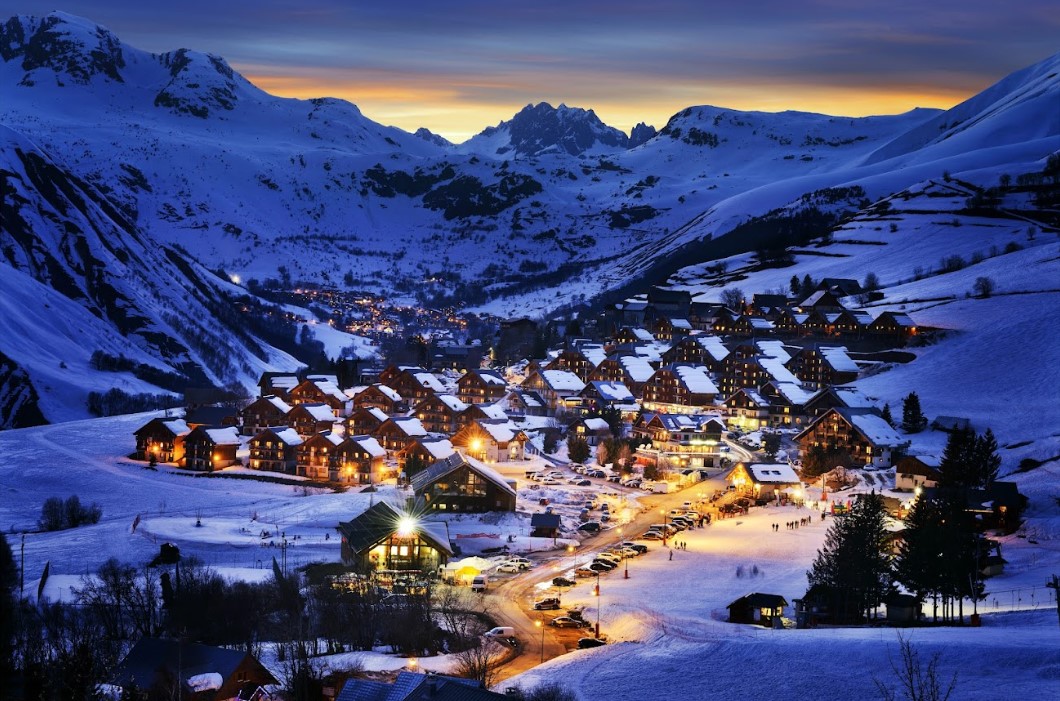
The Pyrenees
The Pyrenees, which border France and Spain, are popular for their winter sports and you’ll find plenty of skiing and snowboarding here as well, in resorts like Cauterets, La Mongie and Saint-Lary-Soulan.
It is far less developed than the Alps, however, and the region is physically a little different, with the mountains older and less craggy than the monumental Alpine peaks. It’s also less frequented as a region, a little more isolated and offbeat, so if you want the feeling of winter but a bit away from the crowds, this might be it.
The region also has plenty of thermal spas, so you can relax after a day on the slopes (or ignore the slopes altogether).
You’ll find some world-class destinations here, like the city of Toulouse, often nicknamed the “Pink City” for its terracotta buildings, the walled city of Carcassonne, or the ruins of a string of Cathar castles.
Perhaps surprisingly (because they're high up on mountain ridges) many of the major ones are open to visitors in winter – but only if you're sporty and looking for a rugged adventure. The upside is that you may have entire citadels to yourself, with clear crisp air ideal for photography. The downside is that you'll have to brave slippery paths and sometimes snow to get there. To find out who's open, check the Carcassonne tourist office or the Cathar country tourist office.
The Jura
This is an area I know well, as I have lived here for more than 30 years. The Jura mountains lie across the Rhône River from the Alps, and are older, and lower, ideal for cross-country skiing and snowshoeing.
Spend a day outdoors and gather in one of its many chalet-hotels for some local fare, like Comté cheese (France’s favorite, according to statistics) or Vin Jaune, a yellow wine that originates here. Contrary to what you might think, this is a strong wine-producing region, also known for such local wines as Arbois. If you’re curious about Jura wines, this book will tell all.
2. Alsace
This is one of France’s favorite winter destinations, especially if you love the Christmas spirit.
The region is home to the best Christmas markets, especially in Strasbourg (“Capital of Christmas”) and nearby Colmar, where the entire town looks as though it was plucked straight from a fairy tale, with its half-timbered houses festooned with lights and holiday decorations reflected on the cobblestones streets. Mulhouse, too, has a worthy Christmas market, one that focuses on the city’s textile heritage.
If you're in Strasbourg, you can see several markets on this day tour, which includes Colmar and some of the smaller medieval markets.
 What Christmas looks like in Colmar
What Christmas looks like in ColmarBeyond the markets, this unique region of France is filled with French and German culinary traditions: wine, along the Alsace Wine Route, but also winter dishes like choucroute garnie (sauerkraut with sausages and pork) and tarte flambée (a thin crust topped with cream, onions, and bacon).
 Tarte flambée in Alsace
Tarte flambée in AlsaceParis
Of course.
Paris, in my humble opinion, is perfect in winter.
The sights are less crowded, and the rain glistens on the cobblestones. (Unless you're fortunate to encounter the very occasional snow.)
Come December, bright lights line the streets, and there’s a festive spirit everywhere. The Christmas displays at department stores like the Galeries Lafayette and Printemps are almost worth the entire trip. Christmas markets are spread throughout the city, and the hot chocolate flows.
After a day out in the cold, relax in a hotel with a luxurious spa...
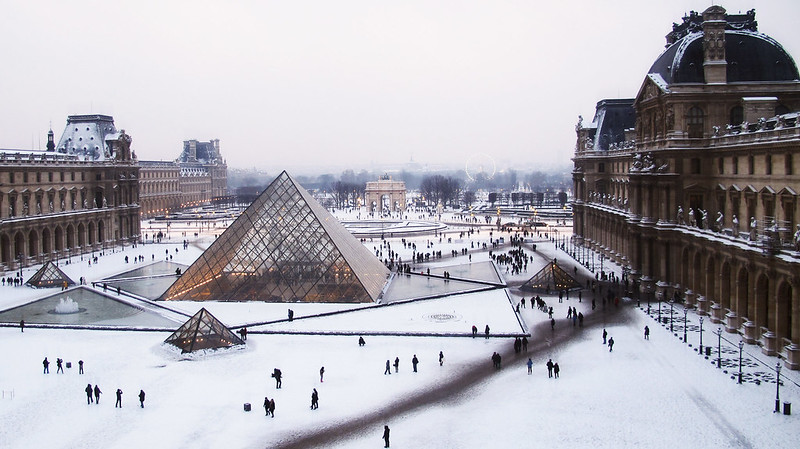 Granted, this doesn't happen often, but when it does...
Granted, this doesn't happen often, but when it does...You can glide under the Eiffel Tower or at City Hall with your rented ice skates – not quite your childhood experience but fun anyway. And make sure you check out the churches, many of which hold concerts and stage beautiful nativity scenes. In fact, Paris is one of the most popular choices for anyone searching for "winter in France where to go", because this is a city that stays lively all year round.
If you’re here in January (anywhere in France, in fact) head for the “soldes d’hiver”, or winter sales. French shops can only put their goods on sale twice a year, and January is one of those times. Discounts are serious, and you’ll be saving plenty. (If you're heading to Paris, you may want to read up on staying safe in the city and avoiding pickpockets.)
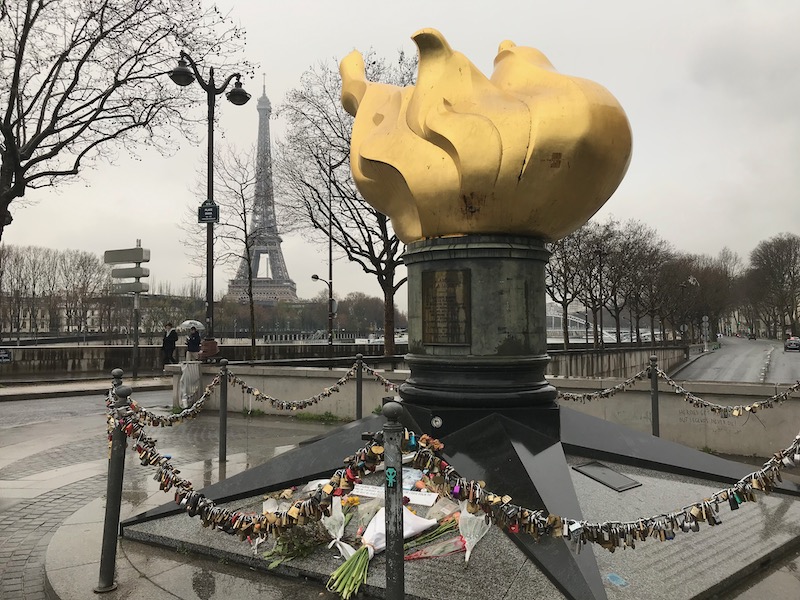
Brittany and Normandy
It’s you and your luck. I visited Normandy twice last winter and experienced plenty of sunshine, and a bit of rain, which disappeared quickly. But luck is a poor travel strategy…
Still, the coasts in winter are stunning, not for bathing, but for brisk windswept walks surrounded by natural beauty of shores like the iconic cliffs of Etretat.
This is also the region of delightful fishing villages with plenty of rich culinary traditions, or larger port towns like Honfleur or Saint-Malo, filled with history. The expansive D-Day beaches are perfect for winter visits. During the quieter months, you’ll be able to experience these to the fullest, without the crowds (well, fewer, anyway).
 The quiet port of Honfleur ©OffbeatFrance
The quiet port of Honfleur ©OffbeatFrance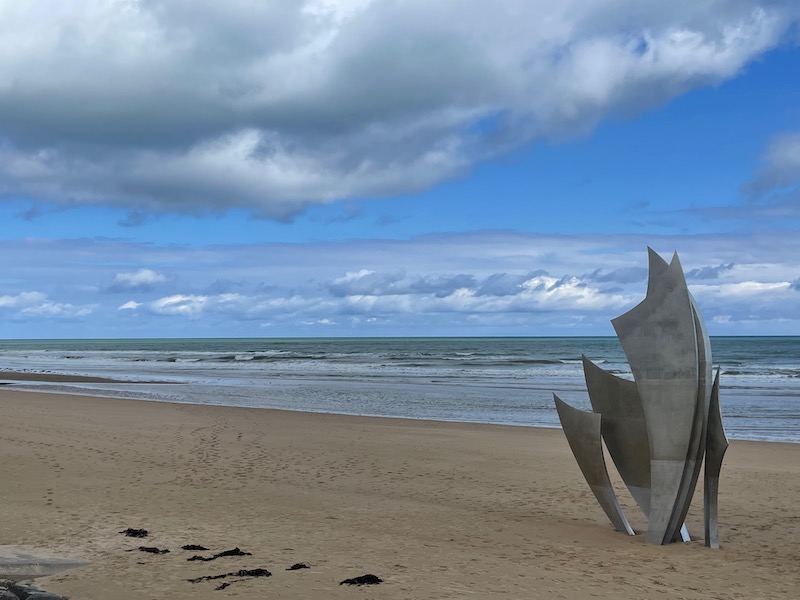 "The Braves" at Omaha Beach, commemorating the June 1944 Allied landing in Normandy ©OffbeatFrance
"The Braves" at Omaha Beach, commemorating the June 1944 Allied landing in Normandy ©OffbeatFranceNipping into a heated museum is always a good idea if it’s unpleasant outside. Normandy is dotted with museums commemorating the Normandy landings of World War II, with the largest being in the city of Caen.
D-DAY TOURS IN NORMANDY
- If there are several of you, this private tour to the major American landing beaches leaves from Bayeux.
- If you're in Paris, you can still visit the D-Day beaches on this full-day tour.
If you're in Caen, there's a lot more to see than the D-Day beaches, and you can explore it on this city tour which includes the castle, the Abbey with William the Conqueror's remains, and Caen's medieval quarter, among other sights.
If you’re in Bayeux, the magnificent tapestry dating back to the 11th century is more than worth a look. Sadly, the museum is closed from September 2025 to spring 2027 for renovations.
On the border between Normandy and Brittany sits one of France's most extraordinary sites: Mont-Saint-Michel, known for its medieval abbey and dramatic tides – one of France's most visited pilgrimage sites.
Brittany’s ancient Celtic heritage adds a layer to the winter experience, and the coastal walks here are world famous.
Both regions have tremendous food and in winter, you’ll have your pick of fabulously fresh seafood, with Normandy particularly famous for its dairy products, all perfect winter fare.
If you’re looking for authenticity, tranquility and nature, this region will provide it, only a two- or three-hour drive from Paris.
The Loire Valley
Heading south, visiting the Loire Valley in winter has both good and bad sides.
First, the good.
The crowds are gone, the winter light can be divine, and the chilled air contributes to the area’s charm and beauty – grand châteaux, vineyards, and quaint villages, with bare vines and frosted landscapes lending the area a distinctive look. The main “royal” castles will also have delightful Christmas decorations, worth seeing.
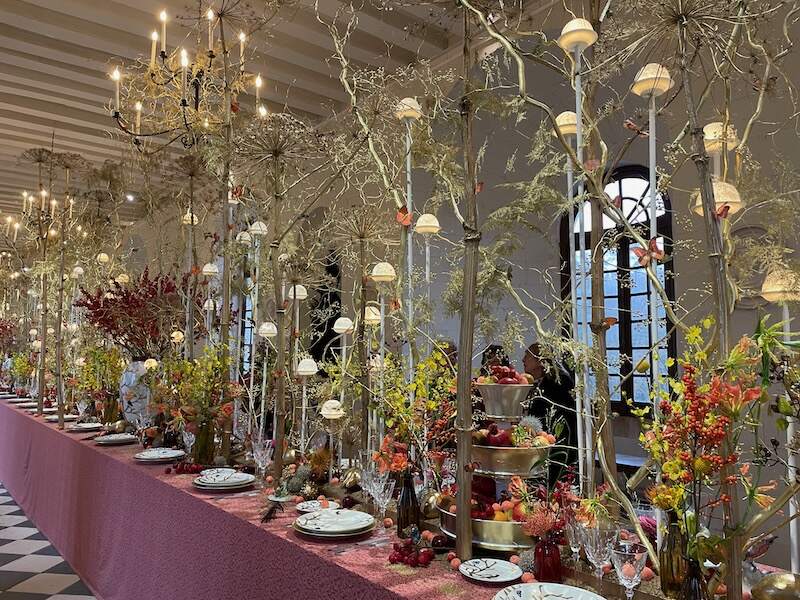 An example of Christmas decorations at Chenonceau ©OffbeatFrance
An example of Christmas decorations at Chenonceau ©OffbeatFranceNow, the bad.
It’s cold, inside as well as out.
This is where many people ask about winter in France temperatures, because the interiors of old stone châteaux can feel colder than the air outside.
I remember visiting the Château de Chambord one February and finding a working fireplace next to which I planted myself until I thawed out. Chinon is equally cold, but then, much of it is outdoors...
Back in Renaissance times, thick tapestries were hung on the walls to keep in the heat, and many chimneys were lit, so one can imagine it was bearable. Some castles, like Chenonceau, are marginally warmer but expect the castles to be cold. Dress accordingly.
WHILE YOU'RE IN THE LOIRE VALLEY...
- Get your skip-the-line ticket to the Château de Chambord
- Enjoy Loire wine-tastings from Tours or Amboise
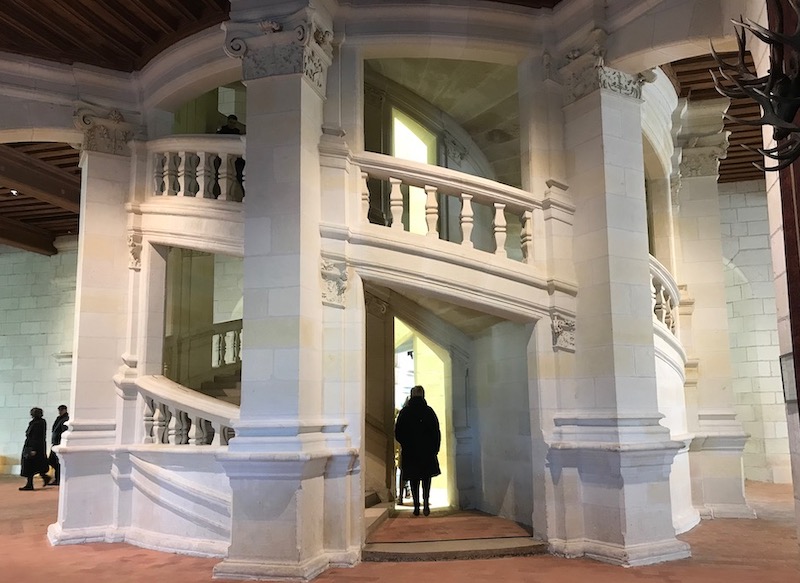
The major attractions are open throughout winter, although with shorter hours. Some of the smaller venues will close for the season, and many restaurants and small hotels may close as well, so check ahead.
There could be snow, although it’s rare, but a white-carpeted château is a sight I’d love to see.
Provence and the French Riviera
The south of France is perfect in winter, a delightful escape from the wet and cold further north. Temperatures are comfortable, the sun shines often, and you can spend most of your time outside.
This is perfect for exploring the region’s otherwise crowded destinations: my favorites include the hilltop villages of the Luberon, the Roman ruins of Arles, the buzzing city of Marseille or the perfume heartland of Grasse (where you can create your own perfume). I’ve visited all these in winter and loved them.
If you happen to be visiting around the end of January or February, the Mimosa Trail is a wonderful driving itinerary through the mountains near the Mediterranean, with bright explosions of yellow flowers at every turn.
 Mimosa bouquets for sale in Provence ©OffbeatFrance
Mimosa bouquets for sale in Provence ©OffbeatFranceBrowse day tours along the Riviera or book a half-day visit while you're in the Mediterranean.
Beware, though, that smaller towns that cater mostly to tourists may have few restaurants or even hotels open, since it’s out of season. Just plan ahead, or move on to a larger town.
There may not be any lavender in Provence in winter, but you can stroll through vineyards and olive groves, enjoying tastings without having to stand in line: think fresh olive oil, olives, wines, tapenade, local charcuterie… Or hike along the coastal promenades, or walk the chic Croisette in Cannes, or take in the opulence of Montecarlo. It's all perfect in winter.
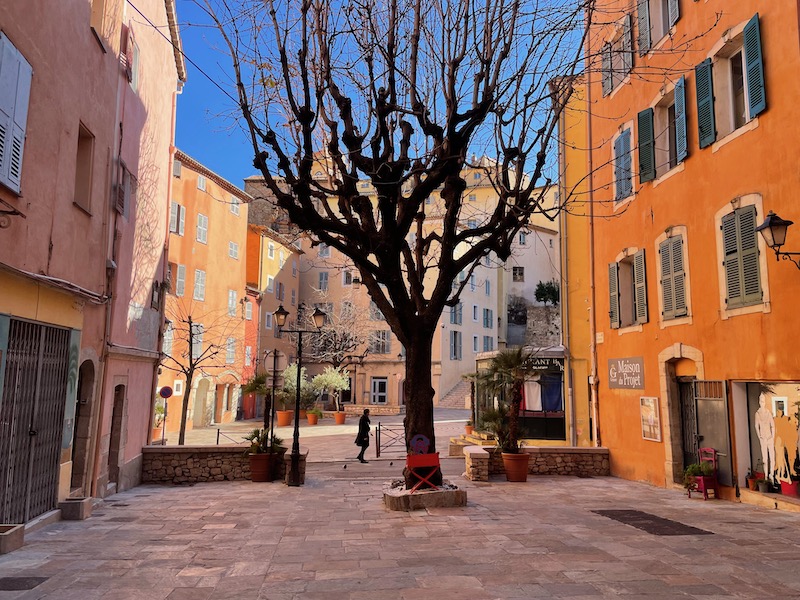
THREE OF MY FAVORITE PROVENCE WINTER VISITS
- My road trip along the Mimosa Route, which I mentioned above.
- My full-day stroll through St-Paul-de-Vence, so crowded in summer you almost need to push through the throngs. In winter? Not a soul around, yet many of the galleries stay open (unlike the restaurants, though).
- My visit to the Villa Ephrussi, a stunning house dating back to the Belle Epoque. Granted, the gardens are bound to be more attractive in summer but the lack of visitors more than made up for their wintry mantle.

Two festivals worth noting: the Nice Carnival, one of the most famous in the world, and the Lemon Festival in Menton, both usually held back to back in January or February.
Oh, and one day in Villefranche-sur-Mer, I caught some hardy souls heading into the sea. They were wearing wetsuits, but still… In February.
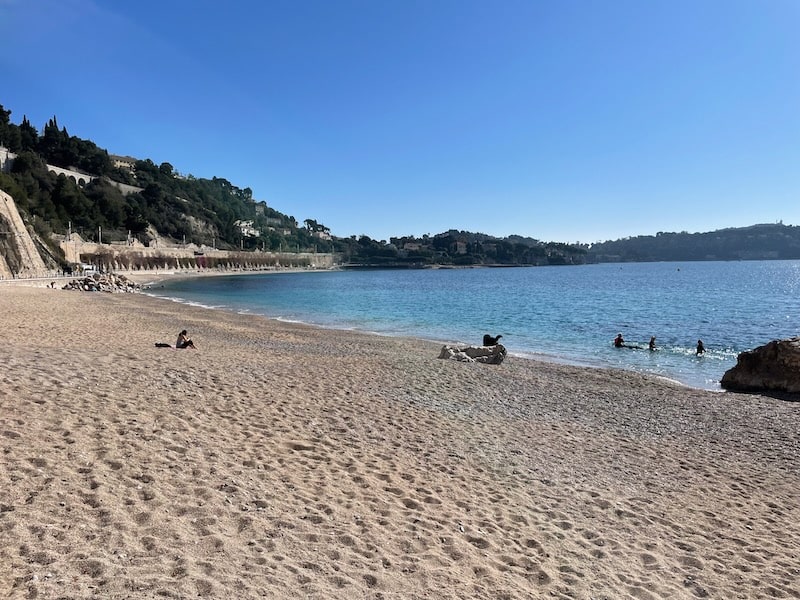 Villefranche, taken on 10 February. Need I say more? I was in a nearby café eating ice cream ©OffbeatFrance
Villefranche, taken on 10 February. Need I say more? I was in a nearby café eating ice cream ©OffbeatFranceSouthwest France
This encompasses a huge swathe of land across the regions of Nouvelle-Aquitaine and Occitanie, from the valleys to the Dordogne through Bordeaux and its wine country to the Basque region which borders with Spain to the interior, near the Pyrenees.
Inland, a favorite in all seasons is the Dordogne, whose picturesque villages, rolling hills and river valleys take on a different – and crowdless – charm in winter. You can relax in towns like Sarlat-la-Canéda and Bergerac and the countryside, often dusted with frost, is still perfect for walking. But beware, while snow is rare, rain and fog are not.
As in many areas popular with tourists, winter is a time of renewal and a few sites and accommodations do close, although the major ones stay open, usually with reduced hours.
The region’s renowned markets, however, will welcome you with open arms.
This is also home to France’s famous prehistoric caves at Lascaux, which remain open, with fewer crowds.
Bordeaux is one of France’s most spectacular cities. Wineries remain open, by the way, so a hop to the charming town of Saint-Émilion, a UNESCO World Heritage Site, should be part of your trip.
At the bottom of France, in its furthest southwest corner, you’ll reach the Basque region, an extension of its counterpart in Spain. Start with the town of Bayonne, heartland of Basque culture, and head south towards the chic Biarritz mansions and the delightful port of Saint-Jean-de-Luz, where walks with dramatic backdrops will have replaced summer surfing and swimming.
This entire region is also renowned for its cuisine…
BORDEAUX AND WINE
- Spend a half-day or a full day sightseeing and wine tasting in Saint-Emilion
- Visit the famous Cité du Vin in Bordeaux
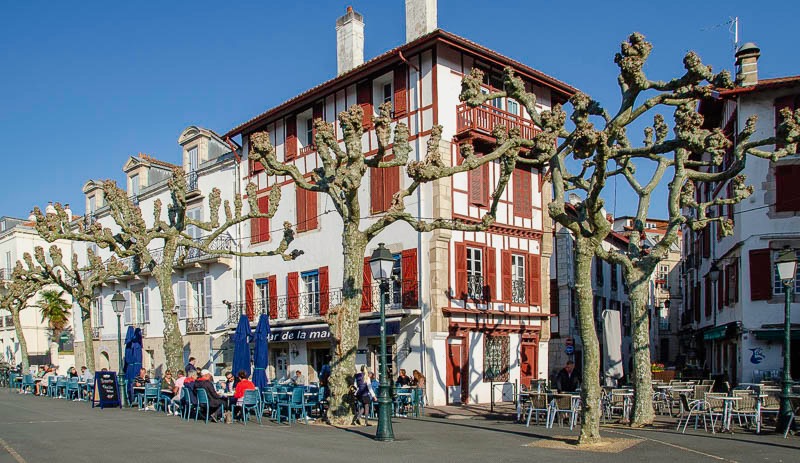
Corsica
This island “département” off the coast of Marseille in the Mediterranean is ideal in winter, but just because it has a mild Mediterranean climate doesn’t mean it’s summer year-round. On the contrary, it is a mountainous region where you’ll find snow up high and even skiing.
But the beautiful beaches will be empty, the cuisine as good as in summer, and the historical sites (Napoleon was born here) enticingly crowd-free. As for its natural beauty, it is every bit as evident in winter as in summer.
If you're staying in town, you can discover Bastia, the island's largest port, on a private tour you can customize, from two hours to a full day. Corsica mostly requires a car, so if you don't have yours, you can rent one by checking here.
FRANCE IN WINTER, MONTH BY MONTH
France in December
- Christmas markets, Lyon Light Festival, holiday atmosphere everywhere, and French Christmas food traditions
France in January
- Carnival season in Nice and Menton, French school holidays (busy ski resorts!)
France in February
- Early spring sun in the south, late snow in the mountains
How to prepare for a winter experience in France
Yes, there are a few basic things you can (and should) do to get ready for a winter visit, so here are my winter travel tips to France.
- Research, but you know that already. You can get a guidebook for the region you’re visiting, or one for France as a whole. Just make sure it has a winter section!
- Plan your itinerary, and keep in mind that things may take a bit longer in winter – snow, winter disruptions and the like.
- Book at least some of your accommodation ahead of time. Winter isn’t a great time to be trudging around trying to find a place to stay.
- If you’re traveling near Christmas, it would be wise to book some transportation as well, especially railpasses but ordinary tickets as well, at least for the longer distances or high-speed trains. (The same goes for car rentals – availability goes down around holidays.)
- Check for attractions and festivals during winter – you don’t want to miss major festivals like the Lyon Light Festival, or carnivals like the ones in Nice or Dunkirk, or major Christmas markets or smaller traditional events by a day or two just because you didn’t know it was happening.
- Make sure you pack according to your destination: heavier clothes for the north, light layers for the south. Accessories are important – hat, scarf, gloves, sunglasses. And don’t forget your bathing suit (spas!)
- Be particularly thoughtful about your footwear − winter wear in the mountains, but something with a grip for cities, especially older ones with cobblestones that turn into mirrors when it rains.
- Cold weather wears down your battery, so make sure you bring along a portable charger or a portable charger or charging bank, as well as a plug adapter for France.
- Remember, there’s more to winter sports than skiing, snowboarding and snowshoeing, and France in winter is ideal to practice some of the less common ones, like ice climbing, winter hiking or sledding.
- France is also world-renowned for its health spas and wellness resorts, and many of the thermal spas in the Alps and Pyrenees do their briskest business in winter, so you might consider a stay in a French spa as part of your winter holiday in France. (In Paris, you could stay at one of these hotels with spas to warm up after a cold day.)
- Check ahead for the weather and be prepared for variations.
- French ski resorts are perfectly equipped and you can rent pretty much anything you need once you get there.
And of course, the usual for any season: a few phrases of the language, valid travel documents, payment methods (including some cash for small expenses), and everything else you would need to prepare a trip to France.
FAQ
Does it snow in France?
Does it snow in France?
Absolutely. Snowfall varies widely during winter in France months, especially between mountains and lowlands, which do get occasional (and often unexpected) snowfalls.
Is France worth visiting in winter?
Is France worth visiting in winter?
Absolutely, but you'll have to choose your region carefully. Winter in France can mean snow sports in the Alps, Christmas markets in Alsace, quiet museums in Paris, bright sunshine in Provence, or even tropical warmth in Overseas France. The big crowds are mostly gone, prices are usually lower (at least away from winter resorts) and in many cases a visit can be much more pleasant than one in the height of summer.
What is actually closed in winter?
What is actually closed in winter?
Plenty, especially in smaller destinations. Modest hotels often close, as do many restaurants that depend on the tourist trade. Attractions in the countryside, such as chateaux, may have reduced hours. And public transport will be scarce or non-existent to some popular tourist areas.
When are the winter sales?
When are the winter sales?
The "soldes d'hiver", as they are called, usually begin on the second Wednesday in January and run for four weeks. Some regions have slightly different dates.
Are Christmas markets only in Alsace?
Are Christmas markets only in Alsace?
Not at all. Most towns in France now boast some kind of Christmas market, and some cities (like Paris of course) have several.
Is it worth visiting the Loire in winter if it’s cold inside?
Is it worth visiting the Loire in winter if it’s cold inside?
Yes. I admit it can be cold in some of the unheated chateaux, but wear outdoor winter clothing and you'll be fine. You'll also be able to see your favorite rooms without having to elbow anyone out of the way.
What's the warmest place in France in winter?
What's the warmest place in France in winter?
This is one of the most common questions about winter in France weather. If you mean "metropolitan" France (the part in Europe) then the warmest will be Nice and the Riviera, the Corsican coast, and some of the more sheltered Provence towns. Beyond this, you'll find truly warm destinations in overseas France, in places like Guadeloupe or Martinique in the Caribbean, or in the South Pacific, in French Polynesia (think Tahiti).
Before you go…
Have I managed to convince you?
France in winter can be an absolutely delight, depending on where you go (plus a bit of luck from the weather gods). For some, it’s the best time to visit France, at least certain parts of it, although other seasons have their own charms.
I live in France and can enjoy all its seasons, but winter has that special clarity and light, and that little extra energy.
Winter appears differently across France, with some regions slowing while others wake up. That mix is part of what makes the season exciting in so many ways.
 The winter view from my window in the foothills of the Jura... ©OffbeatFrance
The winter view from my window in the foothills of the Jura... ©OffbeatFranceDid you enjoy this article? I'd love if you shared it!

